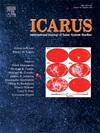橄榄石堆积物露头Issole的岩石成因——火星耶泽罗陨石坑Séítah和Máaz地层之间缺失的一环
IF 3
2区 物理与天体物理
Q2 ASTRONOMY & ASTROPHYSICS
引用次数: 0
摘要
在火星耶泽罗陨石坑的底部,已经绘制并研究了两个岩性单元:Séítah,由富含橄榄石的层状堆积物组成,Máaz,一系列玄武岩到粗面玄武岩熔岩流。虽然Séítah和Máaz的邻近性和地层学都很接近,但它们潜在的地质和岩石学关系尚不清楚。在这里,我们展示了行星x射线岩石化学仪器(PIXL)对Séítah地层中橄榄石堆积露头- Issole的观测结果。Issole分析的岩石以橄榄石(Fo46±1)和间隙相为主,包括辉长岩、晚橄榄石、尖晶石和长石物质。与Séítah的其他露头相比,Issole更富铁,并记录了大量的蚀变过程。我们将矿物化学、结构分析和热力学模型结合起来,表明Séítah橄榄石是由玄武岩母岩浆结晶而成的,其成分与Máaz地层中最原始的玄武岩相似。母岩浆结晶产生的残余熔体遵循Máaz玄武岩定义的岩浆分异趋势。此外,我们的模型在结晶过程中预测的矿物组合与Séítah岩石的观测结果一致,但在组成上存在一些差异。这些差异可以通过考虑改变Séítah矿物组合的后积云过程来调和,包括橄榄石和辉石之间的稀土交换。我们的研究结果表明Séítah和Máaz可能是遗传相关的,它们的形成涉及到深度晶体的积累和熔岩的喷发。Séítah的就位很可能是近地表的岩状火成岩侵入先前喷发的Máaz熔岩流。Séítah和Máaz之间的关系表明,岩浆分异过程,类似于那些负责火星陨石形成的过程,可以在火星地壳中产生高度多样化的岩性和矿物结构。本文章由计算机程序翻译,如有差异,请以英文原文为准。
Petrogenesis of the olivine cumulate outcrop Issole – The missing link between the Séítah and Máaz formations in Jezero crater, Mars
Two lithologic units have been mapped and studied on the floor of Jezero crater, Mars: Séítah, which consists of layered olivine-rich cumulates, and Máaz, a series of basaltic to trachyandesitic lava flows. While Séítah and Máaz are close in proximity and stratigraphy, their potential geologic and petrological relationship remains unclear. Here, we present observations from the Planetary Instrument for X-ray Lithochemistry (PIXL) of an olivine cumulate outcrop – Issole – within the Séítah formation. The rock analyzed at Issole is a wehrlite dominated by olivine (Fo46±1) and interstitial phases, including augite, late olivine, spinel, and feldspathic material. Compared to other outcrops from Séítah, Issole is more iron-rich and records substantial alteration processes. We combine mineral chemistry, textural analysis, and thermodynamic modeling to show that Séítah olivines crystallized from a basaltic parent magma, compositionally similar to the most primitive basalts in the Máaz formation. Crystallization of this parent magma produces residual melts that follow the magmatic differentiation trend defined by Máaz basalts. Moreover, the mineral assemblages predicted by our model during crystallization are consistent with observations from Séítah rocks but show some differences in composition. These differences can be reconciled by considering post-cumulus processes that modified the mineral assemblage in Séítah, including Fe![]() Mg exchange between olivine and pyroxene. Our results indicate that Séítah and Máaz are likely genetically related, and their formation involved both accumulation of crystals at depth and eruption of lavas. The emplacement of Séítah likely occurred as a near-surface, sill-like igneous intrusion into previously erupted Máaz lava flows. The relationship between Séítah and Máaz demonstrates that magmatic differentiation processes, similar to those responsible for the formation of some Martian meteorites, can produce highly diverse lithologies and mineral textures in the Martian crust.
Mg exchange between olivine and pyroxene. Our results indicate that Séítah and Máaz are likely genetically related, and their formation involved both accumulation of crystals at depth and eruption of lavas. The emplacement of Séítah likely occurred as a near-surface, sill-like igneous intrusion into previously erupted Máaz lava flows. The relationship between Séítah and Máaz demonstrates that magmatic differentiation processes, similar to those responsible for the formation of some Martian meteorites, can produce highly diverse lithologies and mineral textures in the Martian crust.
求助全文
通过发布文献求助,成功后即可免费获取论文全文。
去求助
来源期刊

Icarus
地学天文-天文与天体物理
CiteScore
6.30
自引率
18.80%
发文量
356
审稿时长
2-4 weeks
期刊介绍:
Icarus is devoted to the publication of original contributions in the field of Solar System studies. Manuscripts reporting the results of new research - observational, experimental, or theoretical - concerning the astronomy, geology, meteorology, physics, chemistry, biology, and other scientific aspects of our Solar System or extrasolar systems are welcome. The journal generally does not publish papers devoted exclusively to the Sun, the Earth, celestial mechanics, meteoritics, or astrophysics. Icarus does not publish papers that provide "improved" versions of Bode''s law, or other numerical relations, without a sound physical basis. Icarus does not publish meeting announcements or general notices. Reviews, historical papers, and manuscripts describing spacecraft instrumentation may be considered, but only with prior approval of the editor. An entire issue of the journal is occasionally devoted to a single subject, usually arising from a conference on the same topic. The language of publication is English. American or British usage is accepted, but not a mixture of these.
 求助内容:
求助内容: 应助结果提醒方式:
应助结果提醒方式:


